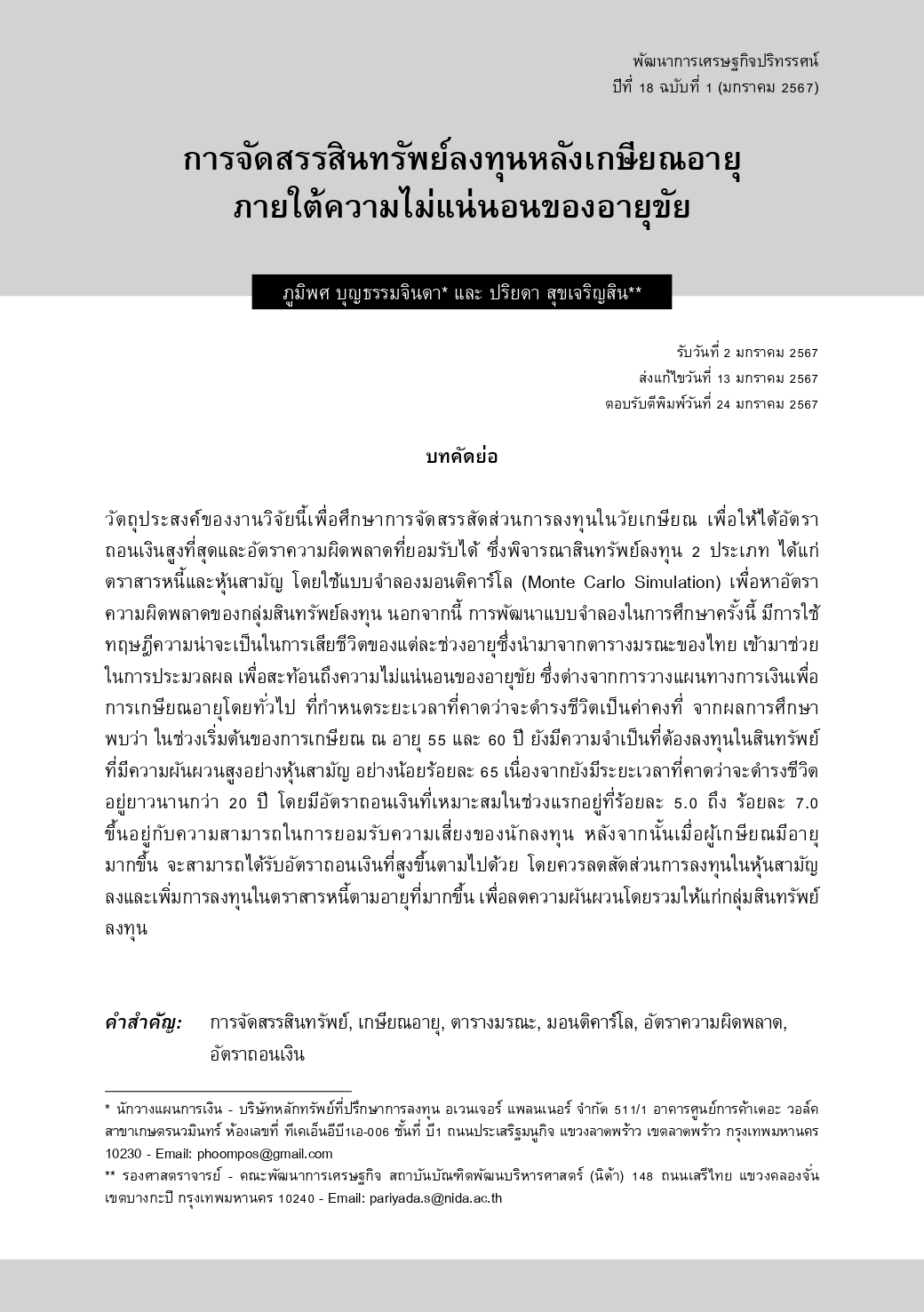Investment Asset Allocation after Retirement under Uncertainty of Life Expectancy
Keywords:
Asset Allocation, Failure Rate, Monte Carlo Simulation, Mortality, Retirement, Withdrawal Rate, การจัดสรรสินทรัพย์, เกษียณอายุ, การมรณะ, มอนติคารโล, อัตราความผิดพลาด, อัตราถอนเงินAbstract
The purpose of this research is to study the asset allocation after retirement to get the highest withdrawal rate at acceptable failure rate. We consider two types of investment assets which are debt instruments and common stocks. The Monte Carlo simulation is employed to find the failure rate of investment portfolio. In addition, we employ the mortality table which shows the probabilities of death for each age group, to reflect the uncertainty of life expectancy. This is different from previous studies which sets the expected length of life to be a constant. From the empirical results, it was found that in the early stages of retirement, at ages 55 and 60, it is still necessary to invest in highly volatile assets such as common stocks, at least 65 percent, because there is still an expected life expectancy of more than 20 years with an appropriate withdrawal rate initially at 5.0 percent to 7.0 percent, depending on your ability to accept risks. After that, when we get older, we will be able to receive a higher withdrawal rate. Then, the proportion of investment in common stocks can be decreased to increase investment in debt instruments as your age increases. Then, the overall volatility of investment portfolio after retirement can be reduced.
References
กรมกิจการผู้สููงอายุุ. (2566). สถานการณ์ผู้สูงอายุุไทย พ.ศ. 2565. กรุุงเทพฯ: บริษัท อมรินทร์ คอร์เปอเรชั่นส์ จำกัด (มหาชน)
ฉัตรชัย สิริเทวัญกุล. (2556). การจัดสรรสินทรัพย์ลงทุนที่เหมาะสมกับวัยเกษียณ. CMRI Working Paper 5/2556. กรุงเทพ: สถาบันวิจัยเพื่อตลาดทุน ตลาดหลักทรัพย์แห่งประเทศไทย.
ตลาดหลักทรัพย์แห่งประเทศไทย. ห้องเรียนนักลงทุน. (2561). ตัวเลขเศรษฐกิจบอกจังหวะลงทุนหุ้น. ค้นวันที่ 13 กุมภาพันธ์ 2561 จาก https://www.set.or.th/set/education/html.do?innerMenuId=18& name=decode_search_invest_9
พิมพ์นิภา ทวีธนวิริยา และ ปริยดา สุขเจริญสิน. (2566). รายจ่ายด้านสุขภาพของประเทศไทยในอนาคต ภายใต้แนวโน้มการเพิ่มขึ้นของผู้สูงอายุที่มีภาวะพึ่งพิงกับค่าใช้จ่ายในการดูแลระยะยาว. Development Economic Review 17(2): 57-80.
Bengen, W. P. (1994). Determining Withdrawal Rates Using Historical Data. Journal of Financial Planning, 7(4): 171-180.
Blanchett, D. M. (2007). Dynamic Allocation Strategies for Distribution Portfolios: Determining the Optimal Distribution Glide Path. Journal of Financial Planning, 20(12): 68-81.
Cooley, P. L., Hubbard, C. M., & Walz, D. T. (2011). Portfolio Success Rates: Where to Draw the Line. Journal of Financial Planning, 24(4): 48-60.
Harlow, W. V. (2011). Optimal Asset Allocation in Retirement: A Downside Risk Perspective. Putnam Institute – Retirement (June), 1-15.
Pfau, W. D. (2011). Nearly Optimal Asset Allocations in Retirement. Journal of Financial Planning’s Between the Issues, 24(9): 1-10.
Stout, R. G., & Mitchell, B. J. (2006). Dynamic Retirement Withdrawal Planning. Financial Services Review, 15: 117–131.
Terry, R. L. (2003). The Relation Between Portfolio Composition and Sustainable Rates. Journal of Financial Planning, 16(5): 64-72.

Downloads
Published
Issue
Section
License
Copyright to published manuscripts becomes the property of the Graduate School of Development Economics, National Institute of Development Administration. Reproduction of all or part of a Development Economic Review (DER) article by anyone, excluding author(s), is prohibited, unless receiving our permission.
Disclaimer: Opinions expressed in articles published in this journal are those of the author (s) and do nto necessarily represent opinions of the Graduate School of Development Economics, National Institute of Development Administration. Trade and proprietary names are only for identification and not constitute our endorsement.

